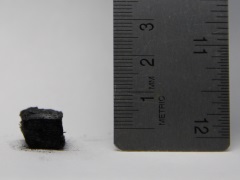Features
Wood gains range of superpowers
Date: 2018-03-14 12:35:44.0
Author: Jon Evans

A wood carbon sponge rebounding to its
original shape after compression.
Photo: Chen et al..
Two very similar treatment methods can produce wood with some impressively enhanced, but very different, physical properties. One method can produce a sponge-like wood that is highly compressible, able to rebounded from substantial compression multiple times. The other method can produce a wood that is more than 10 times stronger and tougher than normal, making it stronger than many titanium alloys and tough enough to stop bullets.
The two methods were developed by teams led by Liangbing Hu at the University of Maryland, US. Both methods begin by boiling the wood in a mixture of sodium hydroxide and sodium sulfite to remove a proportion of the hemicellulose and lignin, which are more soluble in this mixture than cellulose. This causes a partial collapse of the normal lamellar structure of the wood.
To then make it spongy, Hu and his colleagues further treat the wood with hydrogen peroxide, which removes more of the hemicellulose and lignin, before freeze-drying it, which causes the broken cell walls to attach to each other. This converts the normal tubular channels that make up the lamellar structure of wood into a spring-like network that looks much like the interior of a mattress. As a final step, Hu and colleagues heat the wood to 1000°C to carbonize it, fixing the spring-like network in place and creating what they term a wood carbon sponge.
In a paper in Chem, Hu and his colleagues report converting balsa wood into just such a sponge. With its spring-like structure, this balsa sponge could be compressed by 80% and then rebound back to its normal thickness for 10,000 cycles without suffering any damage. What is more, the electrical conductivity of the sponge also changed when it was compressed, allowing it to form the basis of a working strain sensor.
"Our results reveal that rigid and incompressible balsa can be made highly compressible by a chemical treatment and carbonization process, yielding a wood carbon sponge with mechanical compressibility and fatigue resistance and electrical response sensitivity surpassing those of most reported compressible carbonaceous materials," says Hu. With these properties, the wood carbon sponge could find use in applications such as wearable electronics, rechargeable batteries, supercapacitors and catalyst supports.
To make the treated wood stronger and tougher, Hu and his colleagues simply squeezed it under a pressure of 5MPa and a temperature of 100°C for a day. With much of the hemicellulose and lignin having been removed, this process packs the cellulose nanofibrils tightly together and also aligns them, greatly increasing the amount of energy required to break the chemical bonds between them.
As a consequence, when they tried this with a range of different woods, including oak, poplar and pine, they found that the resultant densified wood had a tensile strength of 587MPa, almost 12 times higher than normal wood. Even more impressively, this high strength was combined with toughness, meaning the ability to deform without breaking, when the two are usually mutually exclusive. As Hu and his colleagues report in a paper in Nature, the densified wood had measures of toughness that were 10 times higher than normal wood.
"It is as strong as steel, but six times lighter. It takes 10 times more energy to fracture than natural wood. It can even be bent and molded at the beginning of the process," said team member Teng Li from the University of Maryland. When Hu, Li and their colleagues combined five layers of densified wood together, such that the aligned cellulose nanofibrils in each consecutive layer were at right-angles to each other, they found it could stop a bullet from an air gun.
Interestingly, the secret to the high strength and toughness of this densified wood appears to be the removal of most, but not all, of the lignin. When Hu and his colleagues tried squashing untreated wood, they found that the lignin prevented the wood from being compacted to the same degree. Squashing wood in which all the lignin had been removed, however, simply crushed it, presumably because there was no lignin to act as a binder. Only when some lignin remained did the squashing produce densified wood that was strong and tough, or freeze-drying produce a wood sponge that could be repeatedly compressed.
The views represented here are solely those of the author and do not necessarily represent those of John Wiley and Sons, Ltd. or of the SCI.
Displaying 1 keywords used to tag this article:
- Patek Philippe 7071R Copier-010 - R
